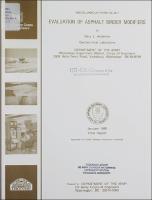Please use this identifier to cite or link to this item:
https://hdl.handle.net/11681/10144Full metadata record
| DC Field | Value | Language |
|---|---|---|
| dc.contributor | Air Force Engineering and Services Center (U.S.) | - |
| dc.contributor.author | Anderton, Gary L. | - |
| dc.date.accessioned | 2016-06-20T13:52:53Z | - |
| dc.date.available | 2016-06-20T13:52:53Z | - |
| dc.date.issued | 1990-01 | - |
| dc.identifier.uri | http://hdl.handle.net/11681/10144 | - |
| dc.description | Miscellaneous Paper | - |
| dc.description | Abstract: This report documents a laboratory-based research effort to determine the effects of asphalt modifiers and alternate binders on asphalt airfield pavements. The modified binders were tested to determine their potential for reducing pavement deformation distresses, improving rheological properties, reducing asphalt contents, and improving the asphalt pavement's heat-resistant capabilities under jet engine blasts. An intensive literature search was performed during the first year of the study to gather all of the available information on the modifiers currently available. This information was used to choose 14 test materials, which were tested in the laboratory during the second year of the study. Data resulting from these tests were used to choose the five most promising test materials, which were evaluated further in the third and final year of the study by more detailed laboratory tests. All laboratory mix specimens were made with the same aggregate gradations and under as near identical conditions as possible. An AC-20 grade of asphalt cement was chosen as the base asphalt for all modified asphalt blends. Asphalt mix testing consisted of indirect tensile, resilient modulus and unconfined creep-rebound tests. Asphalt binder tests included kinematic viscosity, Brookfield viscosity, penetration, resiliency, and chromatography. The results of this research study indicate that no single asphalt modifier or alternate binder is capable of providing all of the performance improvements cited by the objectives of this study in every set of field conditions. Nevertheless, this research did reveal a small group of modifiers and alternate binders that consistently rated better in the tests critical to the desired improvements outlined by this study's objectives. Included in this group of top performers are the oxidant, SBS, polyethylene and EVA modifiers as well as the AC-40 and natural lake asphalts. These materials are recommended for use in asphalt airfield pavements in order to improve the pavement's resistance to rutting and other pavement distresses. NOTE: This file is large. Allow your browser several minutes to download the file. | - |
| dc.publisher | Geotechnical Laboratory (U.S.) | - |
| dc.publisher | Engineer Research and Development Center (U.S.) | - |
| dc.relation | http://acwc.sdp.sirsi.net/client/en_US/search/asset/1041705 | - |
| dc.relation.ispartofseries | Miscellaneous paper (U.S. Army Engineer Waterways Experiment Station) ; GL-90-1. | - |
| dc.rights | Approved for public release; distribution is unlimited. | - |
| dc.source | This Digital Resource was created from scans of the Print Resource | - |
| dc.subject | Asphalt cement | - |
| dc.subject | Asphalt concrete | - |
| dc.subject | Runway pavements | - |
| dc.subject | Asphalt modifiers | - |
| dc.subject | Brookfield viscosity | - |
| dc.subject | Chromatography | - |
| dc.subject | Creep modulus | - |
| dc.subject | Deformation | - |
| dc.subject | Indirect tensile | - |
| dc.subject | Kinematic viscosity | - |
| dc.subject | Penetration | - |
| dc.subject | Resiliency | - |
| dc.subject | Resilient modulus | - |
| dc.subject | Rutting | - |
| dc.subject | Temperature susceptibility | - |
| dc.title | Evaluation of asphalt binder modifiers | - |
| dc.type | Report | en_US |
| Appears in Collections: | Miscellaneous Paper | |
Files in This Item:
| File | Description | Size | Format | |
|---|---|---|---|---|
| MP-GL-90-1.pdf | 28.29 MB | Adobe PDF |  View/Open |